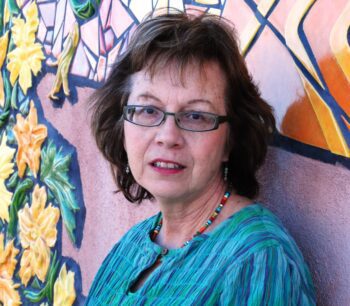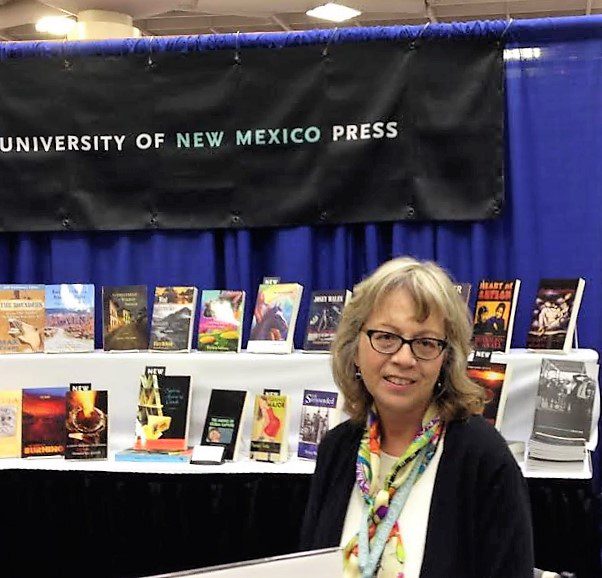
Sharon Oard Warner has never shied away from tackling complex social issues in her writing. Her first novel, Deep in the Heart, explored the heated debate around reproductive rights within a fundamentally religious community. In 1995 Warner edited a short story collection The Way We Write Now: Short Stories from the AIDS Crisis, which chronicled the ways in which AIDs changed the way we think about love and loss, illness and courage. Warner’s legacy has also been one of kindness and mentorship to other writers. For the last seventeen years she has presided over the Taos Summer Writers’ Conference, known for being one of the most inclusive conferences in the country. I had the pleasure of meeting Sharon at the conference in 2012 and found the atmosphere that she created to be hugely encouraging, especially for early-career writers. In 2016, the conference will move to Santa Fe and will be known as the University of New Mexico Summer Writers’ Conference in Santa Fe.
Warner’s most recent novel, Sophie’s House of Cards, reckons with teenage pregnancy and the idea of what it means to be a family. Set in New Mexico, the novel traces the lives of Peggy, her daughter Sophie, and the Tarot card reading that changes their lives. We discussed homelessness and poverty in Albuquerque, the time she was hitchhiking and got picked up by Jerry Garcia, and the importance of structure in her writing process.
***
The Rumpus: Sense of place is hugely important to this book, and you bring Albuquerque (and Taos) so vividly to life. Since we both live here, I’m curious as to why you decided to set the book in New Mexico. What did you want to convey about life in this part of the country?
Sharon Oard Warner: Recently, another interviewer asked whether Sophie’s House of Cards could be set elsewhere, in Texas, say, or Kansas. He was commenting on the structure of the book, which is organized around a tarot card reading a mother gives her teenage daughter.
Honestly, it never occurred to me to set the novel anywhere other than New Mexico. A novel about the intersection between fortune and fate requires a backdrop of immensity and antiquity. Mystery is at Sophie’s center, and New Mexico is steeped in mystery. After all, the Land of Enchantment is our state motto; if magic happens anywhere, it happens here. Artists are drawn by the extremes of the landscape and the quality of the light. We all know the photographs of Ansel Adams and the paintings of Georgia O’Keeffe.
Some stories can happen anywhere, while others are rooted in and motivated by a sense of place. Think of Breaking Bad, which made our city familiar and infamous to millions of television viewers. Can you imagine that show set elsewhere? In Dallas, say, or Kansas City?
 Rumpus: I think a lot of people who have seen the show but never lived in New Mexico might feel inclined to say that Breaking Bad could have been set in any city with a decent crime rate but they’d be wrong. The backdrop of the Sandia Mountains and the bleakness of a dusty, spring day provided the perfect setting for the beauty and destruction emblematic of that show.
Rumpus: I think a lot of people who have seen the show but never lived in New Mexico might feel inclined to say that Breaking Bad could have been set in any city with a decent crime rate but they’d be wrong. The backdrop of the Sandia Mountains and the bleakness of a dusty, spring day provided the perfect setting for the beauty and destruction emblematic of that show.
Warner: Right. And then there’s the absurd premise—a high school science teacher and family man, stricken with cancer, turns to making meth to leave his family a nest egg. This sort of screwball estate planning is plausible in Albuquerque because, hey, we’ll do any damn thing for family.
Sophie is set in the oldest area of Albuquerque—Old Town and the Near North Valley. As you know, Old Town is a tourist attraction now, a plaza lined with shops and studded by a mission church, San Felipe de Neri, but its beginnings date back to 1706. If you think about the fact that the Declaration of Independence wasn’t signed until 1776, you realize that this city has a long history, even longer when you consider the Petroglyph National Monument on the west side of Albuquerque. The North Valley was once largely agricultural, and it is still crisscrossed with working acequias or ditches. Here and there, residents cultivate a field, mostly with alfalfa. Some of my neighbors keep horses and chickens, ducks and pigs, even the occasional llama or donkey. Watch where you walk; you’re liable to tread in horse droppings.
I’ve been in New Mexico for twenty-one years, long enough to weary of the “woo-woo,” but that doesn’t mean I’ve lost my sense of wonder and bewilderment when it comes to this state. Even things like the brilliant blue of the sky are a challenge to describe. The sky is bigger and bluer in New Mexico than it is in Texas or Kansas or Louisiana, other places I’ve lived in the past. And history is alive here in ways you don’t encounter elsewhere.
Rumpus: Can you expand on that? What does it mean to live in a place where history is alive?
Warner: Back in 1998, New Mexico celebrated the 400th anniversary of the settlement of the American West, and in particular the expedition of Don Juan de Oñate, who founded the Province of Santa Fe de Nuevo Mexico and served as its first colonial governor. Descendants of the Spaniards are proud of this heritage. After all, Santa Fe is the state capitol and one of the most famous cities in the world. But Native Americans regard Oñate as a butcher. He was responsible for the Acoma War of 1599, which resulted in the deaths of 800 people in the pueblo—men, women, and children. After the war, the governor took his vengeance by ordering that all the remaining Acoma men lose one foot.
Fast-forward four hundred years: When Spanish descendants honored the conquistador by erecting a twelve-foot sculpture of Oñate astride his horse, a stealthy group of Native men took their revenge. They soldered off the foot of the statue in remembrance of their ancestors. This act served to educate newcomers like me. I was moved by that act. Most of us live in the present, ignorant of the sacrifices of our forebears, but New Mexicans have long memories.
Rumpus: You mentioned Breaking Bad, and though it put Albuquerque on the map, it also depicted our community as one of violence and drugs. I really appreciated your balanced portrayal of our city—you showed the great things, but you didn’t turn away from the struggles we’re having here. I’m thinking specifically of the inclusion of Donald, the homeless teen, who has a small role in the book.
Warner: New Mexico is one of the poorest states in the nation. Twenty percent of our population earns less than the $10,000 a year. It’s a precarious existence; one bad month and you can find yourself on the streets. When I was a girl, people didn’t live out of grocery carts. My aunt Rene was schizophrenic and unable to work, but she wasn’t homeless. If she wasn’t with family, she was in assisted living. On any given day, Albuquerque streets are home to more than 6,000 people. And you don’t hear our presidential candidates deploring the situation or offering solutions. Silence on the subject of homelessness.
I should add that Albuquerque is doing a number of things right when it comes to homelessness. All last year, my son Corey worked at a wonderful facility called Heading Home which is making a real difference in the lives of so many homeless people here in New Mexico. And our city has done something wonderful in creating and funding a school called New Futures, which provides pregnant teens and teen moms with educational, medical, and counseling services, as well as childcare on site. Did you know that New Mexico ranks first in the number of teen pregnancies? Out of all fifty states, I mean.
Rumpus: I didn’t, though that doesn’t surprise me. I’m originally from Walsenburg, Colorado, a very small town four hours north of Albuquerque. At the end of my time in high school and during the beginning of my college years, Huerfano County—where Walsenburg is located—had the highest rate of pregnancy in all of Colorado. Southern Colorado and much of New Mexico share many of the same problems. However, in the last six years, Southern Colorado found the funding to push long term birth control and, consequently, there has been a huge decline in teenage births.
Warner: And I bet Planned Parenthood was front and center in that initiative.
Rumpus: Walsenburg is fairly rural so there were no reproductive health services in the area until about 10-12 years ago. Women used to have to drive about forty miles to Planned Parenthood in a nearby town. Now there is a women’s clinic through the local hospital, but I think the work that Planned Parenthood does is so important.
 Warner: When I was eighteen, living on my own, and in need of birth control, I went to Planned Parenthood and am so grateful for the services I received there. Those of us who know firsthand the crucial role Planned Parenthood plays in the lives of young woman need to stand up and shout NO to all those short-sighted, misguided Republicans. Okay, here I am doing it: NO, NO, NO.
Warner: When I was eighteen, living on my own, and in need of birth control, I went to Planned Parenthood and am so grateful for the services I received there. Those of us who know firsthand the crucial role Planned Parenthood plays in the lives of young woman need to stand up and shout NO to all those short-sighted, misguided Republicans. Okay, here I am doing it: NO, NO, NO.
My first novel, Deep in the Heart, examined the various sides of the abortion issue. Teen pregnancy is at the center of Sophie’s House of Cards. Sophie’s trip to Planned Parenthood is detailed in the chapter titled, “What Crosses Her.”
Rumpus: I was pleased to see the New Futures School included in the book and so relieved that there was a place where Sophie could continue her education and meet other girls she could relate to during her pregnancy.
Warner: One of the first schools of its kind in the United States, New Futures has changed the lives of countless teens, helping the mothers earn their high school diplomas and providing quality care on site for the babies and toddlers of these teens. It’s a great place. I volunteered there for a couple of years, serving as a guest lecturer in English classes.
Rumpus: We’ve discussed the inclusion of Albuquerque in Sophie’s House of Cards, but why did you decide to include Taos as one of the settings in the book? Obviously the fact that you run the Taos Writers’ Conference plays into this choice. We get so much rich imagery of the landscape there.
Warner: At the height of the hippie influx, thirty communes were flourishing in the area around Taos. In just one summer, the summer of 68, more than 10,000 of the unwashed hippie sort showed up in Taos! Of course, most of the Taoseños hated those kids, and I don’t guess I blame them. Sophie’s mother, Peggy arrived in November of 1969, one step ahead of a three-day blizzard, without a coat, without a soul to turn to and all of eight dollars in her pocket. At that age, I was just that wackadoodle: My husband likes to tell people that I hitchhiked from San Francisco to Dallas in 1971, which is true, and that Jerry Garcia once gave me a ride from one side of Marin County to the other, also true.
I relished writing about the hippies in Taos. If you want to know more about that period of time in Taos, I suggest John Nichols’s memoir, If Mountains Die, and Iris Keltz’s book, Scrapbook of a Taos Hippie.
Rumpus: The inclusion of Tarot determined so much for this book: setting, plot, etc. The structure itself is something to be admired. Why did you decide that every chapter would be a Tarot card based on the reading given to Sophie at the beginning of the book?
Warner: Each chapter serves to address both the position in the Celtic Cross layout as well as the card that came up in the reading Peggy gave Sophie. The chapter titles are taken from the Celtic Cross layout: The Seeker, What Covers Her, What Crosses Her, Beneath Her, Behind Her, What May Come, Before Her, Herself, Her House, Her Hopes and Fears, the Outcome.
I started with the structure, not with the characters or the story. The novel has its genesis in a lecture by the writer, Wayne Johnson. He was describing novels structured around motifs in general and Annie Proulx’s The Shipping News in particular. (The chapters of that book are named for nautical knots.) At the time, I had just reviewed Whitney Otto’s novel, How to Make an American Quilt, which makes similar use of quilting ephemera. In the midst of the lecture, I had an ah-hah moment: You could write a motif-driven novel structured around a tarot reading. I knew a little something about the cards, you see, because around the time Jerry Garcia gave me a ride, I was taking a semester-long class on Tarot cards at Marin County Community College. He might have given me a ride to class for all I know.
Rumpus: The structure made me wonder about your revision process. Did you have to move plot points and character development based on the cards for each chapter? How much restructuring went into this?
Warner: Figuring out how to integrate structure and story such that they served and supported one another was a long process. In the beginning, I tried borrowing from Whitney Otto’s technique in How to Make an American Quilt, wherein she alternates chapters with sets of instructions. I wrote instructions on tarot that I interspersed with regular chapters, but in my hands, or with my story, the device detracted rather than served. Eventually, I found a way to incorporate the structure into the story, and the last thing I wrote for the book was the prologue, a letter from Peggy to her daughter Sophie, in which Peggy reflects on the cards and the reading.
Rumpus: Has structure always been at the forefront of your mind when working on an initial draft?
Warner: Yes. When I was your age and a graduate student at the University of Kansas, I began reviewing first novels for outlets including the Dallas Morning News, the Des Moines Register, the Kansas City Star, and the New York Times Book Review. Here’s my favorite take-away from that experience: First novels often fail from faulty construction. They aren’t built well. The framework for the book needs to serve and support the story’s plot and themes. The overall design of the book needs to have logic and integrity. Easier said than done of course.
Rumpus: As you’ve done publicity for Sophie’s House of Cards, you’ve given Tarot readings. I’m thinking particularly of the readings you did at the Associated Writing Programs Conference (AWP) last April. What has it been like actually giving your own readers Tarot readings?
Warner: I have never read cards for others, in part because I haven’t memorized the meanings of all seventy-eight cards. But one of my favorite authorities on the cards, Rachel Pollack, is a proponent of learning on the job, so to speak. She says she learned the cards by giving readings with a book or books in her lap. So, I took her advice and gave readings at AWP in Minneapolis, using Pollack’s book, The New Tarot Handbook, as my reference. Since April, I have given additional readings at book signings, most recently at the Spanish Market in Santa Fe. The readings have been a revelation.
books in her lap. So, I took her advice and gave readings at AWP in Minneapolis, using Pollack’s book, The New Tarot Handbook, as my reference. Since April, I have given additional readings at book signings, most recently at the Spanish Market in Santa Fe. The readings have been a revelation.
Rumpus: In what way?
Warner: Well, the cards are amazingly accurate. One quick example: At AWP, I read for a very attractive middle-aged woman with her best friend in tow. I didn’t ask these strangers to reveal their questions to me in advance, only to specify whether it was a personal or professional inquiry. This woman told me hers was a personal question. The cards she selected told the story. All I had to do was read them. As I began to talk about the two court cards—a younger man and an older man—the best friend’s jaw dropped. Turns out this married woman was in the midst of an affair with a younger man.
Rumpus: You’ve said that Sophie’s House of Cards grew out of four short stories. At what point did you know you had a novel?
Warner: I knew it was going to be a novel from the get-go and that it would probably take me a number of years to write it. My initial plan was to write a few stories to develop the characters and the situation and then to publish those stories. As an English professor, I am expected to publish regularly and widely. Novelists are at a bit of a disadvantage when it comes to frequent publications. So, my thought was to advance the project through stories. Three of the four were published in Prairie Schooner, and a story called “Love Child” came out in the Laurel Review. So to some extent, this strategy worked in that the publications served me in my academic post. But the stories got in the way of the development of the novel because they were already artifacts, fixed and finished, whereas the larger novel was still a work-in-progress. I allowed the completed stories to get in the way of my imagination, which was silly and unnecessary but happened nonetheless.
Rumpus: Each character in this book has a very detailed backstory as well as hopes, fears, and passions. How did you come to so deeply inhabit all of the characters? I’m thinking particularly of Ian and Jack here, who are critical to the story but not in the same way as the female characters, yet they are rendered just as fully. Ian’s being tortured by bullies and Jack had a heart attack and is focused on his beekeeping and house renovations. Did you map out arcs for each character ahead of time or did their internal lives and backstories come to you more organically in the writing process?
Warner: Developing characters is one of the most challenging parts of the fiction writing process. Some writers make it a little easier on themselves by using people in their real lives as models. Recently, I’ve read several biographies of D. H. Lawrence, and the consensus of the critics is that Lawrence based almost all of his characters on people he knew fairly well. His depictions were evidently quite accurate, in that friends and family members recognized their thinly disguised counterparts. Sometimes, Lawrence’s models were pleased with the portraits, but often they were hurt or angry.
Me, I am more comfortable making things up, and it’s more work, frankly. I’m married to a psychologist, and am therefore obligated to make my characters both consistent and psychologically complex. In the last couple of years, I’ve begun using the Meyers-Briggs research on personality types to peg my characters.
The Meyers-Briggs Personality Inventory is a 93-item assessment that looks at an individual’s preferences with regard to extraversion/introversion, sensing/intuition, thinking/feeling, and judging/perceiving. The work of Carl Jung and his book Personality Types strongly influenced the development of the Meyers-Briggs assessment tool. Take the test, and you’ll learn your personality type, one of sixteen different possibilities, some of which are much more common in the population than others.
Rumpus: Yes, I’ve taken that. I’m an INFP. What are you, Sharon?
Warner: I just retook the test to make sure and came out with ENFJ, the Protagonist.
Books and websites offer in-depth commentary on these sixteen personality types that spell out tendencies across the spectrum. It’s fascinating stuff and extremely helpful to a novelist, whether or not you buy the bottom line. (My husband the psychologist is a Meyers-Briggs skeptic.) In any case, the field of psychology offers fiction writers all sorts of ways to better our understanding of human behavior, and that’s our bailiwick, right?
Rumpus: Can you tell me a little about the screenplay you’re working on? What prompted writing something for film instead of fiction?
Warner: I wrote my first novel as a screenplay. When I sent it out, agents recommended that I turn it into a novel. Writing a screenplay is a good exercise in developing character and structure.
Rumpus: How do people usually react when you tell them you’re beginning with a screenplay and then turning it into a novel? With the pressure to publish, a lot of writers are product based and want to have the thing in front of them right away so they can send it out.
Warner: I don’t know! I don’t talk much about my work. That said, I believe it’s inevitable to lose a fair percentage of what you write, though everything you put on the page contributes to the finished product. It’s like peeling a mango. Some of the fruit goes the way of the drain, but there’s no other way to find that sweet, golden center. You can’t worry about what’s lost in the process. A lot of it’s going to get lost, but there’s no other way to get to the fruit.




